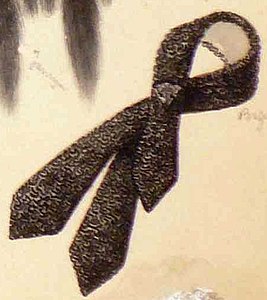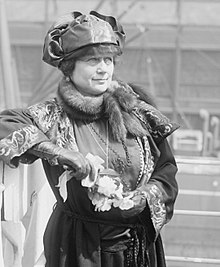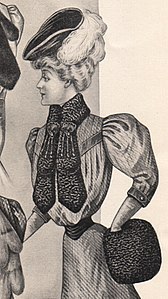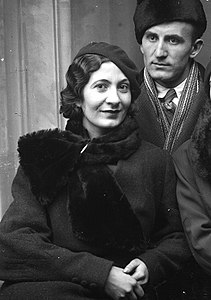Fur tie
As fur tie or just tie a small, rather narrow ladies scarf made is fur called. Larger designs are fur scarves, fur boas and fur stoles, neck scarves made in the shape of an animal are called fur necklaces . The term fur tie is becoming increasingly obsolete, in its modern design it is now traded like the larger version as a fur scarf.
In the past, the term fur tie encompassed different collar shapes as required by the respective fashion. Mainly it represented a narrow strip of fur, which was either evenly wide, but mostly widened towards the two ends. There were also ties and ties. Assortments of various small parts, for example a fur hat , muff and tie of the same type of fur, were called fur trimmings.
design
The fur tie can be made as a straight strip so that it stands up when worn and leans against the neck. Alternatively, it has a more or less pronounced round neck, with it lying flat on the neck on the shoulder. Usually the tie is lined on the back, smaller versions often have fur on both sides ("double-skin").
As a tied tie, it is conventionally worn either looped, otherwise both ends hanging smoothly next to each other on the chest or crossing at an angle. To prevent slipping or falling, the two halves are connected with one or more fasteners. These are usually hooks and eyes spun with trimmings or a pair of snaps made as a pair of balls. A slanted silk bar on the back for pushing through allows the tie halves lying flat on top of each other to cross. The shape, previously known as a slip-on tie, has a central slit on one side through which the opposite side is pushed so that the two halves also cross. Occasionally smaller ties were provided with a collier clip on the back , with which they could be clipped over the opposite side.
The design options are varied. More modern models usually ended with sloping ceilings, double-skinned narrow ties often rounded, short only in the manner of a gentleman tie with a central peak, more rarely, as in the past a lot, with several coat tails. They can also be adorned with sewn-in ornaments or sewn-on, especially floral fur ornaments. Individual decoration with decorative pins by the wearer is also conceivable.
Usually, the back is lined with a silk matched to the fur color , possibly with decorative piping of the connection between fur and lining that is only visible on the back.
history
The word tie , which originally referred to a tie, the members of the Slavic Croatian tribe - Croatian riders wore a corresponding neck tie - is similarly used for the fur scarf in other languages. In German it was taken over from French, together with fur tie fashion, where it is called “cravate”, in Italian “cravatta” and in English “cravat”.
Towards the end of the 19th century there was hardly any fur clothing worn with the hair facing outwards, but together with the introduction of the fur sewing machine it soon began to take hold on a large scale. In the western world, sets of small pieces of fur made of the same fur were already particularly fashionable around this time, and combinations of ermine fur were particularly noticeable. A fur hat could belong to a set, usually a fur muff, sometimes also fur gloves and usually a small fur tie or a larger fur scarf. Ermine ties were usually adorned with the black-tipped tails of the ermine fur, and more often a small "plastered head" was added. Sets for children were also very fashionable, often made of the ermine-like white rabbit fur or the also white, curly slink lamb . Images of small fur shawls from the time before the advent of fur trimmings are rarely found, mostly they were large and representative.
Shoulder collars and capes made of fur were worn with the evening dress, and in a simple design also over the street costume. The fur stole and the fur tie were added to the fur collar, which, like the boa, soon largely disappeared in this form. At the beginning of the 1920s there was the long, evenly wide fur scarf, which also only remained in fashion for a few years. The tie was now long and narrow, or in its subsidiary form, as a single-skinned strangler with a head and tail, tightly enclosing the neck . The different collar shapes that complete the coat and jacket were also worn as separate fur collars. The fashion of fur trimmings persisted into the 1920s, but without disappearing completely until the Second World War.
The Italian Anna Municchi found that collars and other neck furs had established themselves as permanent accessories in other fashion in the 1930s. They were consistently in the collections of important fashion designers, such as Jeanne Lanvin , as a tie made of civet fur at Elsa Schiaparelli or as a neck scarf made of broadtail at Jacques Heim . Municchi also mentioned knotted, rounded or stern-looking " plastron " ties that could be worn with a dress after taking off the coat.
In addition to the fur headgear, what remained was the fur tie, which a woman could wear with a fur jacket or coat. While larger, representative fur scarves and stoles were much more common before, the smaller, simpler fur tie became very popular as a daily accessory for some time after the Second World War. With the increase in mink fashion, mink fur also dominated fur tie fashion. Small ties were made from a mink fur, half a fur per half, the smallest versions from the smaller female mink females, the larger ones from the male mink males. More lavish ties were made from two minks, while small ones were made from four skins placed side by side in pairs. The transition from the term tie to scarf was accordingly fluid. The mink necklaces with heads, tails and paws, which were also quite popular in the post-war period, were later converted into "double-skin" ties by the furrier by simply removing these appendages and sewing them together behind the former heads.
Types of fur
Skinning mainly uses flat skins for ties that can be looped and tied. Mostly, fur ties were made from the skins of the various smaller species of marten, especially: mink , sable , tree and stone marten , polecat , Kolinsky , ermine and weasel . Ermine and weasel skins in particular are so small that the ties are usually made from more than two skins. In addition, other types of fur are also used for ties, especially in times when certain furs are preferred by fashion, for example malecolor , chinchilla fur or the curly or moiré Persians in the 1950s to 1970s. Short skins, such as the Feh and Chinchilla, are placed on top of each other in the required number.
Until the 1940s, skunk fur was particularly preferred by fashion. The fur is usually characterized by a distinctive fork mark on the back. Since this vivid pattern was undesirable at the time, the forks were cut out prior to processing. A strip industry had developed in the fur center of Leipzig's Brühl , which produced semi-finished products for further processing . This is how these white stripes were also collected and put together to form larger, wide stripes , among others by Greek furriers who had been particularly skilled in this field for decades. Mostly fur ties were made from it.
For ties in the lower price range, rabbit fur was mostly used, which can be refined as an imitation of more expensive types of fur , but also makes a very attractive fur in its various breeds.
Sheepskin Tie (Romania, undated)
processing
One- to four-skin fur ties have a central seam in which the fur is parted. A particularly inconspicuous but labor-intensive connection for this is the Polish serrated seam . A Polish seam requires less working time , which is also supposed to prevent the seam stitches, but also the mostly colored undercoat, from being visible. Multi-skin ties made of very small skins are also worked next to each other, with the hairline towards the outside, so that the parting seam is omitted.
If the tie is to be longer than the natural length of the coat, several skins are placed on top of each other or, in the case of larger skins, lengthened by leaving them out at the expense of the width. A slight additional gain in length also arises if a neck rounding is incorporated in the same working technique by letting it round, as is usually the case. The full round of the neck is not taken into account, as it looks more pleasing if the tie is placed against the base of the neck by raising it.
Up until the 1930s, the back was often not only simply lined, but often decorated with elaborate lining work .
Web links
Individual evidence
- ^ The foreign dictionary, Duden , Volume 5, Dudenverlag Mannheim et al., 1997, p. 452, keyword tie.
- ↑ a b Alexander Tuma: Pelz-Lexikon. Fur and Rough Goods, Volume XIX . Alexander Tuma, Vienna 1950, p. 70, keyword “tie” .
- ^ The dictionary of origin, Duden , Volume 7, Dudenverlag Mannheim et al., P. 367, keyword "tie".
- ↑ Alexander Tuma: The history of the skinning . Verlag Alexander Tuma, Vienna 1967, p. 241.
- ↑ Eva Nienholdt: Fur fashions of the 20th century . In: Das Pelzgewerbe No. 5, 1957, Hermelin-Verlag Dr. Paul Schöps, Berlin et al., P. 215.
- ↑ Anna Municchi: Ladies in Furs 1900-1940 . Zanfi Editori, Modena 1992, p. 125 (English), ISBN 88-85168-86-8 .
- ↑ a b c Heinrich Schirmer: The technique of skinning . Verlag Arthur Heber & Co., Leipzig 1928, pp. 139–140.
- ↑ Without author's name: Fashionable ABC . In: Die Kürschnerfibel No. 10, supplement to the Kürschner-Zeitung No. 33, Verlag Alexander Duncker, Leipzig, November 21, 1937, p. 124.
- ^ Editing, with the assistance of Richard Gloeck , Leopold Hermsdorf, Friedrich Hering, Richard König (all Leipzig tobacco shops), Dr. Ingo Krumbiegel, Alfons Haase (Buenos Aires): Skunk and its provenances . In "The tobacco market" XXXI. Vol. 1/2, Leipzig January 2, 1943, p. 6.













